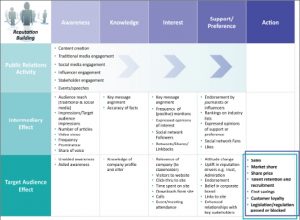
This post is a paper I wrote for my Public Relations Measurement & Evaluation course at Syracuse University in the summer of 2013. This review is of Angela Jeffrey’s, APR, article “Social Media Measurement: A Step-By-Step Approach” published by the Institute for Public Relations. .
“The majority of public relations practitioners (and marketers) have no real idea of what is working and what is not in their social and digital programs,” claims Angela Jeffrey, APR, despite the industry’s many and varied responses, such as the Barcelona Declaration of Measurement Principles, to the need for measurements standards. To try to rectify this situation, Jeffrey establishes an eight-step social media measurement process to use with the International Association for Measurement and Evaluation of Communication Valid Metrics Framework.
Using a combination of work by Jim Sterne and Katie Paine, setting goals for the organization, the first step of the process, falls into seven overarching categories: 1) To raise revenue; 2) To lower costs; 3) To increase customer satisfaction; 4) Sales or marketing gains; 5) Increasing engagement; 6) Improving relationships or reputations; and 7) Increase brand preference and loyalty. As Jeffrey points out, it’s important to realize, though, the goal will be reached by using many channels in a PR program, only one of which is social media.
Moving into the second step of the process, targeted publics need to be identified for each goal an organization sets. Jeffrey advocates that internal and external research should be undertaken to pinpoint these stakeholders, specifically external research that she claims “is the single most important step one can take in building an effective organization.” I find her use of social graphs, a detailed report on where key stakeholders are on social media, especially useful for measurement. Though labor intensive, these graphs provide valuable information. The other two methods of external research she supports are offline listening through surveys and online listening through keyword and message analysis. This research also serves as the benchmark for a social media measurement program.
Once key stakeholders and where they are at are identified, it’s time to prioritize them and their attached goals. After prioritization is finalized, a PR professional can then move onto step three and set SMART objectives for each group. To be evaluated, objectives need to be Specific, Measurable, Attainable, Results-orientated and Time-bound.
After objectives are established, then the communications program with Key Performance Indicators can be built. In step four, KPIs, dependent upon the objectives, will help the practitioner know his tactics are on track for success. I especially liked that Jeffrey explains how KPIs are a target to aim for. Using an example from the white paper, if your objective is to generate sales leads, a KPI would be number of downloads of an informational brochure on your website that you aim to happen 150 times in a month.
Step five is where the physical AMEC Valid Metrics Framework comes into play when the practitioner establishes tools and benchmarks. In my opinion, the framework is one of the easiest visual measurement representations to understand. The framework has been applied to Brand/Product Marketing, Reputation Building, Issues Advocacy/Support, Employee Engagement, Investor Relations, Crisis/Issues Management, Not-For-Profit, and Social/Community Engagement campaigns.

The framework breaks the PR practice down into three main areas: 1) The message is created and shared; 2) the message is disseminated to a third party; and 3) the message is consumed by the target public. These three phrases are represented on the vertical axis as 1) Public Relations Activities, metrics reflecting efforts in producing and disseminating messages (inputs); 2) Intermediary Effects, metrics reflecting third-party dissemination of message to target publics (outputs); and 3) Target Publics Effects, metrics showing the target public has received the message and actions resulting from that (outtakes and outcomes). On the horizontal axis, the stages of the communications or marketing funnel are represented with Awareness, Knowledge, Interest, Support and Action. Inside the matrixes, metrics are grouped to demonstrate a campaign’s success, the goal being to move diagonally across the matrix from top left to bottom right.
For metrics in the Public Relations Activities matrixes, efforts are recorded to later compare with resulting responses. Though business results can correlate with PR efforts, these are not the final results of the campaign. In the Intermediate Effects matrixes, Jeffrey urges practitioners to obtain more sophisticated metrics in interest and support through measuring owned media sites, such as websites and social media pages, and non-owned media sites or earned media, such as external blogs. Set KPIs for each set and track the growth of these channels. Non-owned media sites can be measured using content analysis source strength. Finally, metrics for Target Audience Effects show the actual relationship between the three phases and are measured by surveys, web analytics and other quantitative methods.
After completing the AMEC Valid Metrics Framework, it is time to analyze the results and determine if they were worth the cost of the campaign, step six. Jeffrey quotes Margot Sinclair Savell when it comes to understanding the meaning behind the quantitative data: “Data does not equal intelligence. Analyzing the data brings actionable insights and recommendation that can be used to revise future strategy.” I like this insight because too many times we throw up figures and charts to show what we’ve done, but if we can’t explain the meaning behind it, how it’s affecting the company’s bottom line, what is it worth?
Speaking of worth, Jeffrey presents an interesting debate among professionals in the white paper about showing PR’s ROI, or, more precisely, the incorrect use of that term when results are not of a financial nature. As I read more about the formulas used to calculate ROI and its precise meaning, I’m leaning more into the camp that is against the use of ROI for PR results and more in favor of using non-financial terminology to show value, such as cost-effective analyses.
In step seven, Jeffrey provides tips on presenting the campaign results to the CEO. She recommends using a dashboard or scorecard that highlights the most relevant information, especially anything that shows hard data, such as survey results or correlations to outcomes, as executives tend to relate best to quantifiable data. She cautions, though, to also provide informal results to give context to this quantifiable data.
Finally in the last step, Jeffrey explains that “to glean insights and make course corrections is the real reason for measurement in the first place” and this cannot be done without a regular schedule of evaluation. As Sterne identifies a healthy online community as one that is growing, useful, popular, responsive, interactive and lively, Jeffrey encourages practitioners to consistently analyze the health of their communities.
This white paper is value-laden with information that is useful for all PR professionals pursuing measurement methods. I especially like how Jeffrey explains how the AMEC Valid Metrics Framework works while including several appendices with in-depth information on measurement methods and links to affordable measurement products.



